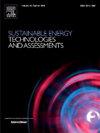利用光谱技术快速预测商业生物柴油氧化稳定性的PLS-R校准模型
IF 7.1
2区 工程技术
Q1 ENERGY & FUELS
Sustainable Energy Technologies and Assessments
Pub Date : 2025-04-01
DOI:10.1016/j.seta.2025.104286
引用次数: 0
摘要
氧化稳定性是生物柴油的重要质量指标,广泛使用rangimat®加速氧化法进行评估,需要6或13小时才能符合现行法规。在这项研究中,我们建议使用直接和快速的分析技术结合偏最小二乘回归(PLS-R)和1H NMR和FTIR-ATR光谱来预测商业生物柴油的氧化稳定性。评估模型质量的统计参数表明,两种方法都表现出良好的性能,残差预测偏差(RPD)值超过1.6,相对标准偏差(RSD)低于9.3%。分析值(AFOM)也产生了良好的结果,定量限(LOQ)和检测限(LOD)与研究范围一致。对于核磁共振数据,zgig脉冲序列(大大减少1H-13C卫星信号)被证明更适合建模。影响核磁共振模型性能的主要化合物是氢过氧化物及其衍生物。几个显著的振动带有助于模型的性能为紧凑的FTIR。使用单一原料或不添加抗氧化剂的样品可以获得更多的预测模型。然而,一旦生物柴油的生产涉及到不同的原料和抗氧化添加剂,这是不切实际的。包括来自不同原料和抗氧化剂的生物柴油增加了数据集的可变性,导致更现实的模型具有更广泛的适用性。与标准的rangimat®方法相比,具有PLS-R的NMR显着减少了约40倍的分析时间,FTIR减少了约220倍。然而,构建和验证预测模型是费力且具有挑战性的,并且需要数据分析的知识。本文章由计算机程序翻译,如有差异,请以英文原文为准。

PLS-R calibration models for fast prediction of oxidation stability of commercial biodiesel by spectroscopic techniques
Oxidative stability is an essential quality metric for biodiesel, widely assessed using the accelerated oxidation method with Rancimat®, which requires 6 or 13 h to comply with current regulations. In this study, we propose predicting the oxidative stability of commercial biodiesel using direct and rapid analytical techniques combined with partial least squares regression (PLS-R) and 1H NMR and FTIR-ATR spectroscopy. Statistical parameters that assess the quality of the models indicate that both approaches demonstrated good performance, with residual prediction deviation (RPD) values exceeding 1.6 and relative standard deviation (RSD) below 9.3 %. Analytical figures of merit (AFOM) also yielded favorable outcomes, with limits of quantification (LOQ) and detection (LOD) consistent with the ranges studied. For NMR data, the zgig pulse sequence (which drastically reduces 1H–13C satellite signals) proved more suitable for modeling. The main compounds contributing to the NMR models’ performance were hydroperoxides and derivatives. Several significant vibrational bands contributed to the model’s performance for the compact FTIR. More predictive models could be achieved using either samples from a single feedstock or without adding antioxidants. However, this is impractical once biodiesel production can involve diverse feedstocks and antioxidant additives. Including biodiesel from different feedstocks and with antioxidants increased the dataset’s variability, leading to more realistic models with broader applicability. Compared to the standard Rancimat® method, the NMR with PLS-R considerably reduces the analysis time by about 40 times and FTIR by approximately 220 times. However, building and validating predictive models is laborious and challenging and requires knowledge of data analysis.
求助全文
通过发布文献求助,成功后即可免费获取论文全文。
去求助
来源期刊

Sustainable Energy Technologies and Assessments
Energy-Renewable Energy, Sustainability and the Environment
CiteScore
12.70
自引率
12.50%
发文量
1091
期刊介绍:
Encouraging a transition to a sustainable energy future is imperative for our world. Technologies that enable this shift in various sectors like transportation, heating, and power systems are of utmost importance. Sustainable Energy Technologies and Assessments welcomes papers focusing on a range of aspects and levels of technological advancements in energy generation and utilization. The aim is to reduce the negative environmental impact associated with energy production and consumption, spanning from laboratory experiments to real-world applications in the commercial sector.
 求助内容:
求助内容: 应助结果提醒方式:
应助结果提醒方式:


